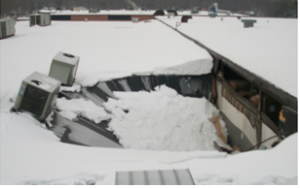WE KNOW THAT MOST FLAT ROOFS WILL LEAK AT SOME POINT, BUT WHAT IS THE CAUSE AND WHAT CAN BE DONE TO PREVENT THESE LEAKS?
If you are the owner or facility manager of a building with a flat roof, you have most likely experienced leaks at some point in your buildings life. If you haven’t, you have been very fortunate and, we hate to say it but, you should probably start saving to make repairs or replacements when you do have a leak. With the pervasiveness of this problem in mind, what are the major causes of flat roof leaks, and what can be done to stop them?
Causes of flat roof leaks:
Harsh Environment

The first cause, harsh climate, is hard to overcome. Unless you pick a region of the country to build in that has a very temperate climate, you will most likely experience significant weather variations and temperature extremes that are tough on your roof. One of the best ways to remedy this problem is a reflective coating. There are many reflective coatings out there, and they are designed to, among other things, keep your roof surface temperature constant. Rather than heating up to 200 degrees in the day and dropping to 60 degrees when the sun goes down, the reflective coating allows the roof to stay much more consistent. Read our article on temperature extremes to learn more about the remedies for this problem.
Standing Water
Another factor that often leads to flat roof leaks is standing water. Standing or ponding water is defined as any water that will not drain or dissipate from the roof surface within 48 hours of precipitation. This problem is created mostly due to insufficient roof slope. A flat roof is not supposed to be truly “flat”, but should have a slope of at least 0.25” inches per foot with drains and outlets placed strategically on the surface.
This is a problem that can seem pretty harmless, after all the water is stuck on the roof, but even if the leak hasn’t developed yet, standing water is dangerous for your roof and should be fought even before a leak develops. You can fight ponding water with pumps on the roof, added drains, or careful roof surface elevation. Be sure to consult a professional before undergoing any significant roof repairs to fight standing water.
Outdated Technology
Finally, if your roof system is old and still utilizes outdated technology, your roof is in danger of springing leaks and failing. Roofing technology has made significant progress over the last few decades, and there are many roofs on buildings today that are in poor working condition because they have become outdated. If this is the problem you face with your roof, you need to begin planning on updating and improving your roof as soon as possible.
Keeping an outdated system on your building is dangerous to everyone inside, and will only lead to bigger problems in the future. The only way to fight the problem of outdated technology is to update your roofing system. Whether that means tearing out and installing a new roof, or simply installing a coating over top of the existing roof is up to you. If you are looking to update your roofing system by tearing out and reinstalling, be sure to research the different types of flat roof replacement options that are available to you.
Be sure to inspect your current roof and, if it is too old and structurally unsound, don’t put a crew with their equipment on top to apply a coating on it. Be smart and safe.
If you inspect your roof and find that you are suffering from any of these problems, research your specific problem a little bit more before you make any decisions. This is not designed to be an all-inclusive list or to contain all the information you need to make your repairs. You’ll need to research more on your own and consult a professional before you take any action.
